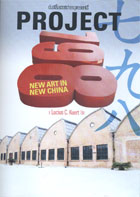
Project 798: New Art in New China 2010
Distributed by Microcinema International/Microcinema DVD, 1636 Bush St., Suite #2, SF, CA 94109; 415-447-9750
Produced by Lucius C Kuert
Directed by Lucius C Kuert
DVD, color, 62 min.
Sr. High - Adult
Art History, Biography, China, Asian Studies
Date Entered: 10/07/2010
Reviewed by Barbara J. Walter, Longmont Public Library, Longmont, COIt’s a familiar story for artists: find a cheap quiet place to live in a run-down part of town, set up a studio and make art. More artists flock to the neighborhood, which, though still shabby, comes alive with creative energy. Art dealers and gallery owners follow the buzz, as do trendy shops and cafes along with the cleaner, safer streets that attract more customers. Rents skyrocket, forcing out the artists responsible for resurrecting the area— who slip away to find a new run-down area where they can make art in peace. Lucius C. Kuert’s documentary Project 798: New Art in New China tells this familiar story, but with a twist: this time the setting is Beijing, and the driving force behind the gentrification of the neighborhood appears to be the government.
Shot on location in Beijing’s Dashanzi Art District, Project 798 sheds light on China’s contemporary art scene as well as the enormous socio-political changes sweeping a country making the transition from agricultural to industrial economy at blinding speed. Kuert allows the artists to tell the tale of the 798 District: intellectual artist Huang Rui, returning to Beijing after a 10-year exile, found inexpensive space to rent in Factory 798, part of a complex of military factory buildings scheduled for demolition; the Gao Brothers moved into the district in part to escape difficulties faced as Chinese artists daring to broach taboo subjects—politics and religion; they are convinced authorities are bent on forcing them out by turning 798 in to a “billboard for the government.” Zhang Xiaogang, Chen Wenbo, Li Songsong, He Yungchang and others address issues of universal concern to artists: the process of making art, sources of inspiration, and the need for community that places like 798 afford. But more interesting to Western audiences is their commentary on the role of art in Chinese society and how it has evolved under repressive Communist rule; the dearth of original artists in a country where for years the height of artistic expression was the political poster; the commercialism that challenges traditional values in Chinese culture and leaves its people disoriented; huge changes in the artistic environment in China over the last decade— the public can now view good art free of censorship in places like 798, and contemporary Chinese art is sought after internationally; and the temptation to pander to Western tastes for financial gain.
“Good art should not be used to decorate—it should be critical. It should analyze and criticize our problems and our society,” contends artist Chen Wenbo. Many of the artists interviewed for Project 798 believe that art of such integrity and power isn’t likely to come from the 798 District anymore—it’s become too commercial, too government-sanctioned, too comfortable for artists willing to avoid taboo topics. Judging from the remarkable painting, sculpture and performance art Kuert has showcased here, contemporary art in China has a firm grip on its conscience and its edge.
Awards
- Best International Documentary (short) 2010 New York Independent Film Festival in Los Angeles
- Golden Ace Award 2010 Las Vegas Film Festival